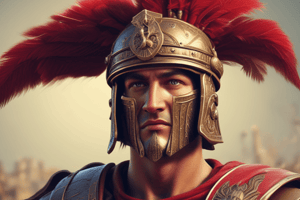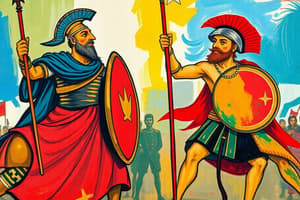Podcast
Questions and Answers
Which other civilization had the greatest impact on the development of Rome?
Which other civilization had the greatest impact on the development of Rome?
- Persians
- Greeks (correct)
- Egyptians
- Celts
What was the form of writing called used by the Romans?
What was the form of writing called used by the Romans?
Latin
Which of the Roman social classes was considered the nobles of Rome?
Which of the Roman social classes was considered the nobles of Rome?
Patricians
Which of the Roman social classes was the largest group considered the commoners of Rome?
Which of the Roman social classes was the largest group considered the commoners of Rome?
What were the Roman legions?
What were the Roman legions?
What was a Roman century?
What was a Roman century?
What were the series of wars that Rome fought with Carthage called?
What were the series of wars that Rome fought with Carthage called?
Who was the leader of the Carthaginian army that invaded Rome by attacking through the Alps?
Who was the leader of the Carthaginian army that invaded Rome by attacking through the Alps?
The increase of the gap between the rich and poor, more powerful Roman generals, and civil wars over who would be in power in Rome were results of problems due to what?
The increase of the gap between the rich and poor, more powerful Roman generals, and civil wars over who would be in power in Rome were results of problems due to what?
What happened to Julius Caesar in 44 BC and which group did it?
What happened to Julius Caesar in 44 BC and which group did it?
Who took power after Julius Caesar and gave himself the title of Augustus or 'Exalted One'?
Who took power after Julius Caesar and gave himself the title of Augustus or 'Exalted One'?
What was the golden age of Rome called meaning the Roman peace?
What was the golden age of Rome called meaning the Roman peace?
What were three causes of Rome's decline and eventual fall?
What were three causes of Rome's decline and eventual fall?
Chariot races, gladiator events, and other forms of Roman entertainment were held at what?
Chariot races, gladiator events, and other forms of Roman entertainment were held at what?
Which Roman emperor tried to restore the Roman Empire by doubling the size of the military, fixing the prices of goods, and dividing the empire into an Eastern and Western Roman Empire?
Which Roman emperor tried to restore the Roman Empire by doubling the size of the military, fixing the prices of goods, and dividing the empire into an Eastern and Western Roman Empire?
Which Roman emperor moved the Roman capital to Constantinople and changed the official religion to Christianity?
Which Roman emperor moved the Roman capital to Constantinople and changed the official religion to Christianity?
What is the Greco-Roman culture?
What is the Greco-Roman culture?
What made Constantinople a good place for a city to be built from a geographic setup?
What made Constantinople a good place for a city to be built from a geographic setup?
What was the Eastern Roman Empire called?
What was the Eastern Roman Empire called?
Which leader combined the Roman law code, oversaw the building of the Hagia Sophia and was considered the greatest emperor of the Byzantine Empire?
Which leader combined the Roman law code, oversaw the building of the Hagia Sophia and was considered the greatest emperor of the Byzantine Empire?
What was the new Roman law code called in the Byzantine Empire?
What was the new Roman law code called in the Byzantine Empire?
Who was Justinian's wife and the first empress of the Byzantine Empire?
Who was Justinian's wife and the first empress of the Byzantine Empire?
What was the division of the Western Roman Church and the Byzantine Church known as?
What was the division of the Western Roman Church and the Byzantine Church known as?
What were the biggest reasons for the differences in the development of the church between the Eastern and Western Roman Empires?
What were the biggest reasons for the differences in the development of the church between the Eastern and Western Roman Empires?
Who was the leader of the church in the Western Roman Empire?
Who was the leader of the church in the Western Roman Empire?
Who was the leader of the church in the Eastern Roman Empire?
Who was the leader of the church in the Eastern Roman Empire?
Items used to help Christians focus on Jesus and God are known as?
Items used to help Christians focus on Jesus and God are known as?
What is the term used that means to be kicked out of the church?
What is the term used that means to be kicked out of the church?
What was the major difference between the Roman gods and the Greek gods?
What was the major difference between the Roman gods and the Greek gods?
What were some of the things that you would see in Roman architecture of an ancient Roman building?
What were some of the things that you would see in Roman architecture of an ancient Roman building?
What was the form of government used in ancient Rome that was America's form of government based on?
What was the form of government used in ancient Rome that was America's form of government based on?
What were the Roman law codes written on for all Roman citizens to see?
What were the Roman law codes written on for all Roman citizens to see?
What was the body of water that Rome controlled after winning the Punic Wars?
What was the body of water that Rome controlled after winning the Punic Wars?
Which position in the Roman Republic was the chief executive officer with two people elected each year to run the government and lead the army into battle?
Which position in the Roman Republic was the chief executive officer with two people elected each year to run the government and lead the army into battle?
What was used by Rome to bring water to towns over long distances, some of which are still standing today?
What was used by Rome to bring water to towns over long distances, some of which are still standing today?
Flashcards are hidden until you start studying
Study Notes
Roman Influence and Society
- Greek civilization had a significant impact on the development of Rome.
- Latin was the primary form of writing used by the Romans.
- Patricians were the noble class of Rome, while plebeians represented the largest group of commoners.
Military Structure
- Roman legions consisted of approximately 5,000 men.
- A century in a Roman legion comprised around 80 men.
Key Conflicts and Leaders
- The Punic Wars were a series of conflicts fought between Rome and Carthage.
- Hannibal was the Carthaginian leader known for invading Rome by crossing the Alps.
Expansion and Internal Issues
- Expansion of the Roman Empire led to increased wealth disparity, the rise of powerful generals, and civil wars over power.
- Julius Caesar was assassinated by Roman senators in 44 BC.
- After Caesar's death, Octavian, who became Augustus, took control.
Historical Periods
- Pax Romana, translated as "Roman Peace," marked the golden age of Rome.
- The decline of Rome resulted from poor leadership, trade imbalances causing debts, and reliance on mercenaries.
Entertainment and Public Life
- Chariot races and gladiatorial events took place in arenas.
Reforms and Changes
- Diocletian aimed to restore the empire by enlarging the military, stabilizing the economy, and dividing it into eastern and western sections.
- Constantine moved the capital to Constantinople and made Christianity the official religion.
Cultural Identity and Changes
- Greco-Roman culture represents the blend of Greek and Roman elements.
- Constantinople's location became a central trade hub.
The Byzantine Empire
- The eastern Roman Empire evolved into the Byzantine Empire.
- Justinian, a prominent emperor, was instrumental in creating the Justinian Code and oversaw the construction of the Hagia Sophia.
- Theodora was Justinian's wife and the first empress of the Byzantine Empire.
Religious Divisions and Practices
- The Great Schism refers to the division between the Western Roman Church and the Byzantine Church.
- Differences in practices, like the use of religious icons, contributed to varying church developments.
- The Pope led the church in the Western Empire, while the Emperor held this role in the Eastern Empire.
Architectural Elements
- Ancient Roman architecture featured prominent structures such as arches, domes, and columns.
- The Roman government layout served as a precursor to the current American republic system.
Legal Framework
- The Twelve Tables were created to document Roman law for public knowledge.
- The Mediterranean Sea was controlled by Rome post-Punic Wars.
Government Structure
- The chief executives, known as the consuls, were elected annually to run the government and lead the military.
- Aqueducts were constructed to transport water to towns over long distances, with many still in existence today.
Studying That Suits You
Use AI to generate personalized quizzes and flashcards to suit your learning preferences.




